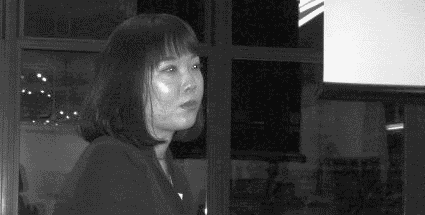
NEW YORK, April 21 — In conjunction with their recent Garo exhibition, the Center for Book Arts hosted an artist discussion with mangaka Kondoh Akino (近藤聡乃). She has been widely published in AX magazine, which is the spiritual successor of Garo. Kondah also produced two books. Currently she is focused on her painting and short animation. [Interpretation by Midori Yoshimoto]
TRANSCRIPT, PART 1 | PART 2
Ryan Holmberg: I’m happy to introduce Kondah Akino who is typically stationed in Tokyo. But, you spent last year in New York, and you are here for how many years?
Kondah Akino: One or two years.
RH: She only tangentially actually related to Garo. I thought more than she is… having read her work. She insists that the connections are thin, but I might push her on some of those [connections]. At any rate, we are lucky that she is in New York. She is a very active and well known alternative manga author who is in the trajectory of alternative manga that Garo(ガロ) founded.
So you made your debut in AX in 2000. Can tell me a little bit about your art practice before you started publishing manga professionally?
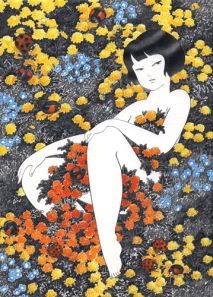 KA: When I debuted as a manga artist, I was a sophomore in university. But I originally started drawing manga as a senior student in high school. At the time, I was also going to prep school for university entrance exams. I was studying art there as well.
KA: When I debuted as a manga artist, I was a sophomore in university. But I originally started drawing manga as a senior student in high school. At the time, I was also going to prep school for university entrance exams. I was studying art there as well.Actually when I was child I wasn’t really a big fan of manga. I wasn’t really reading a lot manga. I didn’t have any particular interest in it. I did hear about Garo as a child. I didn’t actually encounter it until high school.
RH: Your first work was self-published. Is that correct?
KA: Something like that.
RH: Can you explain it? When most people usually think about self-publishing manga in Japan, they think about amateur doujinshi, otaku culture, and ComiKet. Your first work takes a completely different trajectory in regards to self-publishing.
KA: I never participated in doujinshi or Comi-cons. I never participated in anything like MoCCA [Art Fest].
RH: What is the distribution of some of your early work? Self-published comics are fairly typical here, and there are a lot of outlets. In Japan, there are only a couple of outlets.
KA: For my graduation work, I made 500. I reprinted it for my school exhibition and made 100 copies. There was an assignment for a free style competition at my prep school, and I created my first manga with a stapler. I simply binded them together with staples.
RH: [Referring to slides: Girl's High School Life Bookmark(女子校生活のしおり)] Story is set in a Japanese girl’s high school. There are two main characters. One is always sleepy and a bad student. She’s always dreaming. The other one is a typical literary girl who is always spouting stories and making up stories… sometimes lies. There is a slightly erotic connection between them, and the art girl is an object of attraction for the sleepy girl.
KA: I didn’t particularly draw these erotic scenes or connotations. But there might be some depictions that might make you think that one is attracted to the other.
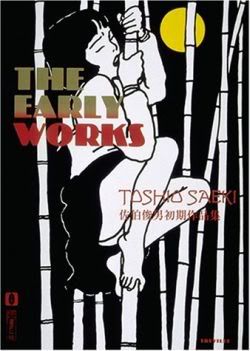
The Early Works by Saeki Toshio
RH: In this panel, she has tadpoles growing out of her hands, and she’s licking them. I’m interested in the stylistic influences. I mean I like the pattern in a lot of these.
We’ve talked about this. It reminds me of the work of Saeki Toshio (佐伯俊男). Saeki Toshio was a very popular illustrator who got big around 1969-1970. He started publishing erotic illustrations in Japanese magazines. [The illustrations] often times involved Japanese high school girls in sexual situations. They were molesting their toys or being molested by old men. There are rough thick lines.
What elements of Saeki Toshio’s work appealed to you?
KA: When I discovered his work, I was a high school girl. It wasn’t his erotic interests or erotic depictions that attracted me. Rather, it was the beauty of his line [work] and the formalistic aspects.
RH: We believe you completely, but... (audience laughs) Look at some [of her work], and there is an erotic element. The types of elements are very much Saeki based such as fluids dripping, licking, and some kind of biomorphic things.
KA: I was primarily attracted to his skills.
RH: Skills at what? (audience laughs) There is also the sexualization of Japanese high school girls. I mean his work is tied up with normative Japanese male sexual fantasies. Your work has a female subject. It was interesting that you appropriated Saeki and use it to talk about women’s issues.
Your first work published in AX for 2000 and won some prize for AX. It’s not the top prize…
KA: The Encouragement Prize. [AX Manga Newcomer's Award / Encouragement Award]
RH: [Referring to slides] It was published in 2000. It was called Kobayashi Kayoko (小林加代子) which is the name of the protagonist. It’s a little hard to summarize. There’s a girl name Kayoko who runs a slipper store. Running a slipper store is a pretty abysmal fate for a young girl. Then she gets a little excited because across the way there is boy. He’s running a light bulb store. Can you tell me a little bit about the story?
KA: This girl is running an unpopular slipper store. She can hardly sell anything, so she’s thinking of turning it into a candy store. Then a boy moves in across the street and begins a dialogue between them.
RH: So, it’s like a romance?
KA: No. It’s not a romance.
RH: I can’t remember the story exactly. She has various crises around her situation. Then later on, if remember right, the boy gives her a TV.
KA: The TV was hers. It was not a gift from the boy.
RH: So, she somehow gets electrified by the boy? What’s the course of the story?
KA: I can’t quite figure out why I came up with this strange story. I had a lot of things to worry about back then, and I just can’t figure out why. (audience laughs)
RH: If I remember right, at the end, she’s about to give up on the candy store. Then she finally decides to keep the slipper store. At the end, you see an expanded slipper outlet.
KA: She started selling the sandals that the boy made.
RH: If I remember right, he cuts out one of the slippers. It’s his invention. This is your first story. I noticed in a lot of your work, there is an interest in a certain retail space in Japan: shopping arcades (Shōtengai 商店街). There is a lot of signage, a lot of clutter, and a lot of specialized stores. What’s the appeal of these shopping arcades?
KA: It wasn’t just growing up seeing these old fashioned retail stores, rather I simply found enjoyment in drawing the details of old fashioned stores.
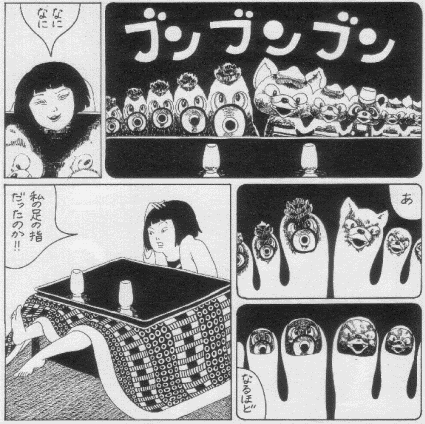
RH: It’s the detailed work of drawing so many objects packed in together? It’s a nice juxtaposition between the density of the arcade in the background and the simplicity of the figures.
The follow up story was not originally published. It only appeared in a book in 2004. It’s called “Around the Kotatsu” (こたつのまわりで). Kotatsu (炬燵) is a table with a quilt, and you put your feet underneath. Traditionally you put your feet down into a hole, and it’s heated. It keeps your feet warm. Modern kotatsu have a heat lamp on the bottom of the table to keep your feet warm. In Japanese households without central heating, typically this is where you congregate in the winter months. It’s kind of a social space. Tell me what happens around the kotatsu.
KA: This girl is similar to the girl who’s always sleeping. She’s always dreaming while sitting at the kotatsu everyday. The boy is simply emerging out of her imagination. It’s a similar story to Kobayashi Kayoko in that the girl is experiencing a bored life. She dreams of things that she can’t do in real life.
RH: In addition to your interest in dense shopping areas, I noticed in a lot of your work that you are interested in textures and patterns. You’re really interested in details. It’s also seems to be connected to an interest in objects. Objects have a real strong presence in your work in different ways. So much so that, [in one panel] the girl ends up merging with the object. It’s kind of a magical quality of objects.
KA: When I talk about story building, I’m referring to the Japanese expression: Kishōtenketsu (起承転結). It means beginning, development, twist, and the end. In the four part story telling system, usually my beginnings stem from my real life experiences. The beginnings are often inspired by specific things.
RH: One example is Box Garden (はこにわ). In one panel, the image is not a pen and ink drawing. It’s graphite, and it has a really strong independent presence which pushes everything out. In a work like this, you really pull out objects sometimes.
KA: I’ve always been interested in containers like boxes and dressers.
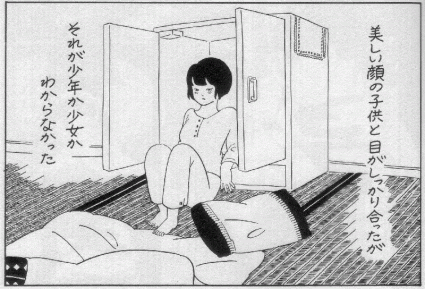
RH: What is the appeal of boxes, dressers, and cabinets?
KA: I don’t know why, but since I was a small child, I liked stuffing things into boxes or containers.
RH: [Referring to slides]In this case, your protagonist opens a drawing leading into a giant world. In the world, I think she sees herself in the past and decides to jumps into it. In a lot of your work, you have an Alice and Wonderland rabbit hole where an alienated woman finds a fantasy land.
KA: I think you are right, but I’m not totally conscious of it.
RH: Have you personally fell down a rabbit hole? (audience laughs) Do you think they exist? Seriously. Often times I see you. I always read the protagonist as you.
KA: My ideal girl is always the protagonist.
RH: The protagonist sometimes has her head in a box. In this case, little Maritians or little Moonlings crawl inside her head.
KA: Sometimes the head is a container as well.
RH: Sometimes the box is a scary place. Tell me a little bit about the story.
KA: In this story, this girl gets trapped in a dresser every night. In the beginning, those hands were snatching her from inside the drawers. They used to be a child’s hands, but they became an adult man’s hands in the end. The lower left panel depicts the moment when she tries to escape. She realizes that it’s not a child that is trying to keep her in the dresser. It’s an adult man.
RH: It’s obviously deals with female sexual aggression tied with these kinds of themes.
KA: It could be interpreted that way, but I’m not conscious of it either. (audience laughs)
RH: Sometime other types of spaces like under the bed sheets are filled with biomorphic and anemone type things. The protagonists are attacked by them. You’ll probably say that it’s not conscious either. The phalluses are coming from every direction. (audience laughs)
KA: It’s totally unconscious. (audience laughs)
RH: Where do these growths come from? Not in the story but the idea.
KA: One of my personal hobbies is researching catalogues of mushrooms and viewing them in botanical gardens. It might come from that hobby.
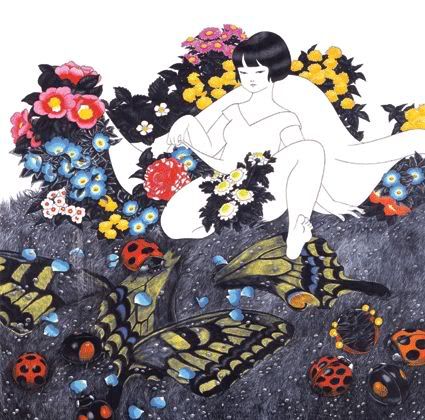
RH: It made me think of a number of things such as stories by Japanese pulp fiction author Edogawa Rampo - Tarō Hirai (平井 太郎). In one of his stories, the male protagonist takes all of the stuffing out of a chair and crawls into it in order to molest people sitting on him. In the Garo show, there's one based on it called “Cockroach Boy”. It’s about a deformed kid who hides between the folds of the comforter and molests the woman through the sheets. There seems to be a theme about things between the sheets.
KA: I didn’t know about Edogawa Rampo's work in particular. I usually draw manga without the intention to express something. I think of things that are visually interesting and start drawing.
RH: [Referring to slides] This stuff also made me think of other similar things such as this prune head guy on the ceiling. I also thought of this [referring to slides]. Midori Yoshimoto wrote a book about female Japanese performance artists. There’s a chapter on Kusama Yayoi (草間彌生). What do you think of it?
KA: Do you want to know what I think of it?
RH: In Kusama’s case… Do you know Kusama Yayoi’s work? No? She had a very comfortable, even obsessive relationship with these phallic themes. You’re a girl who is obviously less content. (audience laughs)
KA: I have a different version of my first published manga, the Box Garden. It depicted actual sculptures that sit in your palm. I made hundreds of them containing mechanical motors. I put the toys inside a set of drawers and presented it as an installation. It won the Kusama Yayoi award. Kusama Yayoi actually chose my work.
RH: Are you interested in Fluxus? It sounds like a Fluxus type of object.
KA: No. Not in particular
[READ PART 2]


No comments:
Post a Comment